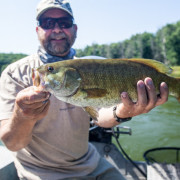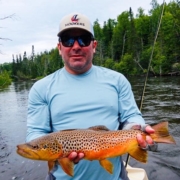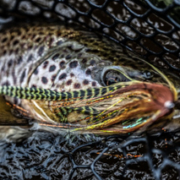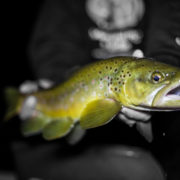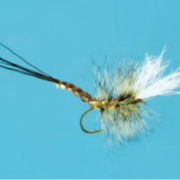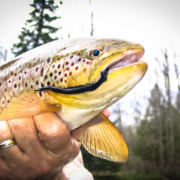Hawkins Little Rascal
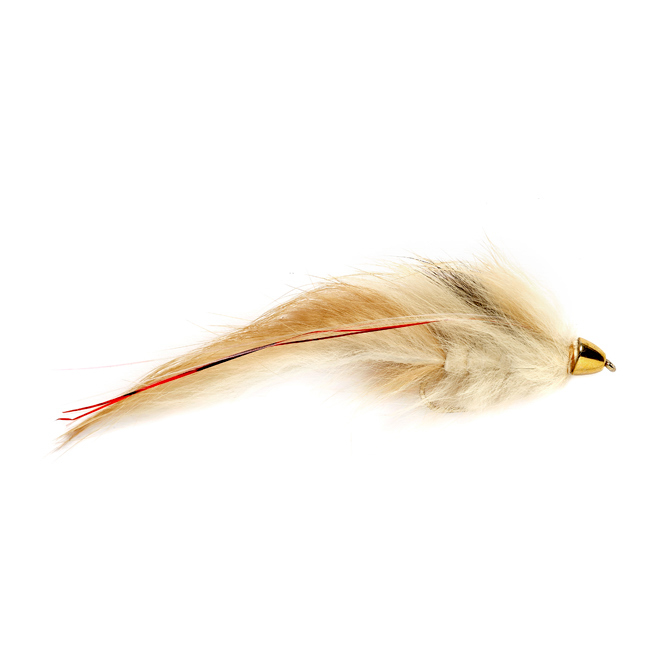
Hawkins little rascal streamer pattern for the Manistee River
Little Rascal
Last spring, I was fishing below Tippy Dam throwing streamers for trout. There were lots of bank anglers fishing spawn sacks and a lot of heavy pressure from boat anglers. The trout were refusing most of our offerings of big streamers and we hadn’t had any steelhead activity. It was a sunny day which usually spells tough times in Michigan trout fishing. That’s just what we were having. As white is a go-to color in sun and olive and white is the most productive color combination that I’ve experienced, I tied on two Little Rascals in those colors for my clients to change things up. Fifteen minutes later we had landed a gorgeous steelhead that darted out from a mid-stream logjam and devoured the fly. Shortly after that we landed that a 4.5 pound brown trout. A star was born.
Size Matters
How come a smaller streamer worked for big fish when big streamers usually get the job done? At Hawkins Outfitters, we fish streamers almost everyday in early and late season because they do catch big fish. Along with my pattern, the Nutcracker, we throw a lot of large streamers that entice big predator fish. But, those same large trout and steelhead see a lot of big streamers and, I believe, grow wary of the same big patterns they see over and over again. Even the best big pattern can start to produce fewer fish if fished too much or too often.
Trout key on different sizes and profiles. Some days it’s four inch sculpins, other times it’s smaller leech or lamprey profiles. That’s why I created the Hawkins Little Rascal. It’s a smaller, slimmer pattern, that imitates leeches and lampreys well. Plus, it has a great, lively movement and action in the water. I tie the tail with rabbit strip to get that movement that trout love. Combine that with the conehead and you get that all-important jigging movement that predator fish often can’t pass up. Plus the conehead gets the fly down better in deeper and heavier water.
Retrieves
We don’t just fish Little Rascals in the spring. You’ll find that you’ll have luck with them year round. You’ll get the best results if you vary retrieves and colors depending on water temps and sky color. When fishing colder water, use a slower retrieve than you would fishing warmer water. The fish’s metabolism is down and the fish themselves are slower at these times and will travel less distance to feed. If your streamer is retrieved more slowly, the fish will see it better and be able to strike. As the water warms, you can quicken your retrieve.
Color
As far as color goes: on dark days use dark colors and on bright days use bright colors. However, there are a couple times that the Little Rascal is a good imitation for a natural food source. In spring there are two food sources, lampreys and salmon fry that can be imitated by a Little Rascal. When you start seeing lampreys on the trout you are catching try a black Little Rascal on cloudy days. I’ve had some great success doing this. When fishing where salmon and steelhead hatch try a small white Little Rascal, it works well. You can fish the Little Rascal in any water conditions except when the water is extremely dirty. Then, you’ll want to stick with a larger streamer. You can also use it for just about any freshwater species. I’ve caught brown, rainbow and brook trout; king, pink and Coho salmon; plus small and large mouth bass on the pattern just this year alone.
Little Rascal 2.0
One of the fun things about owning Hawkins Outfitters is hanging around and trading information amongst the Hawkins Guides. Jon Ray, Ed McCoy, Jeff Topp, Russ Madden, and Steve Pels are some of the fishiest guys I’ve ever known. We constantly exchange information, fish locations, new patterns and techniques etc are community property.
The Little Rascal 2.0 is a result of that sharing. As new materials come along or different tying techniques are learned it is a good thing to look back at some of our patterns. Jon Ray did just that with an old standby of mine, the Little Rascal. What he created we now call the Little Rascal 2.0.
Jon made two big changes to the fly. First he added a vertical mono loop in the rabbit tail to reduce the instance of the tail fouling around the hook. This is a dynamite idea that will be incorporated into all of my rabbit tail flies in the future. The second addition is a dubbing brush palmered up the body along with the original rabbit strip. You know Jon Ray he loves flash!
These two changes are fantastic additions that create a better fly. Less tail wrapping on the hook and a bulkier body with more flash makes this good fly even better. Thank you Jon Ray.
Watch the video blow to see how to implement these changes and tie yourself some 2.0s!!
Good Luck.
Captain Chuck Hawkins

